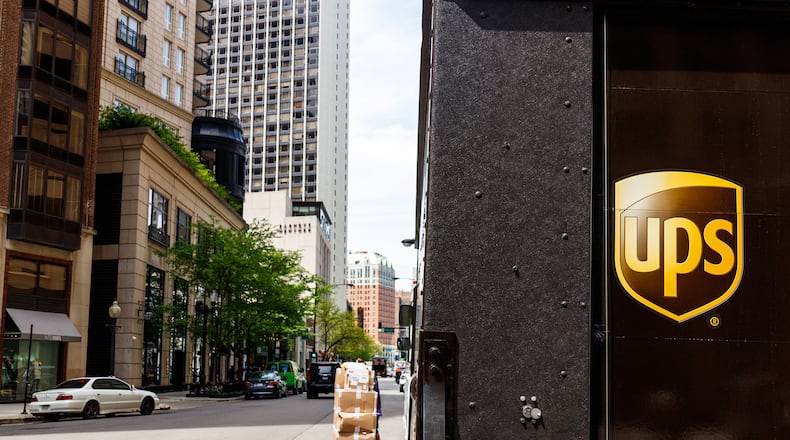Santa’s helpers are stressed.
UPS reported another round of heady revenue and profit growth in the third quarter while continuing to ride the rising wave of e-commerce.
But the Sandy Springs-based delivery giant faces a big test in the coming weeks as it prepares for the busy holiday shipping season that will further challenge the global supply chain and shipping infrastructure.
UPS Chief Executive Officer Carol Tomé said she expects demand will outpace capacity, and that UPS will limit how much holiday package volume it handles to “control chaos costs” when necessary after enforcing limits last year.
“There are capacity, congestion and cost concerns,” Tomé told investors Tuesday during a conference call.
UPS already has increased its fuel surcharges and peak surcharges, which could mean consumers will pay more to get gifts delivered if the higher costs are passed along. It also will soon announce an increase in shipping rates for 2022.
The company’s net income for the quarter ended Sept. 30 was $2.33 billion, up 19% from the same period a year earlier. Its revenue grew 9.2% to $23.18 billion, extending a string of strong financial results since the pandemic as more consumers have goods delivered to their homes.
UPS has expanded operations on weekends and is adding automation in its warehouses with technology such as RFID tags on packages to reduce manual scanning.
But many consumers have had to wait longer and pay more for goods ranging from groceries to cars because of shortages in materials, labor and transportation triggered by COVID-19. And that was before the busy holiday season.
At congested ports in Los Angeles and Long Beach, Calif., third-party companies deliver containers to UPS hubs. Amid a driver shortage, UPS is only receiving about 50 of its capacity of 70 containers a day at one of those hubs, “so it is slowing down the flow of packages,” Tomé said.
While UPS is prepared to deliver packages once it receives them, “in terms of the end-to-end supply chain, it’s jammed upstream,” she said. She welcomed the recent news from the Biden Administration that the ports would expand to 24/7 operations.
Because consumers are “quite panicked” by supply chain problems, and with predictions that 50% of people will finish holiday shopping by Nov. 29th’s Cyber Monday, some retailers are offering earlier sales, Tomé said. More gift cards are expected to be sold, which when redeemed could lengthen the holiday shopping and shipping period into early next year.
UPS is still trying to hire more than 100,000 seasonal workers for its peak holiday period amid a tight labor market. It hired 13,000 people last week and is planning another big push with an extended “Brown Friday” online hiring blitz Nov. 4-6. It is working to attract job seekers by dangling the prospect of making a job offer within 30 minutes for some positions.
As UPS pays more to attract workers, some labor costs are increasing. In the Atlanta area, the company is advertising jobs for warehouse package handlers for $17.50 an hour, more than double the legal minimum wage. Seasonal warehouse jobs in some parts of the country pay up to $22 an hour.
Tomé said the company is working to create “fewer but more impactful jobs,” for example converting more than 1,000 part-time supervisor jobs into nearly 400 full-time positions.
In the U.S. domestic segment, UPS handled fewer packages in the third quarter than a year ago when stay-at-home protocols drove a surge in online shopping early in the pandemic. But the company increased its revenue per package by 12% — reflecting the increased cost to retailers and consumers for shipping an item. UPS also is running a pilot project for “dynamic pricing” in which prices rapidly change depending on demand.
As UPS increases rates and focuses on the highest-margin business, it also is trying to increase its share of business from small- and medium-sized companies that need more services. That in turn affects the largest retailers.
Tomé said UPS continues to support its largest customer, e-commerce behemoth Amazon, as it grows “but we’re not their supply chain. We’re just part of their supply chain.”
About the Author
Keep Reading
The Latest
Featured


